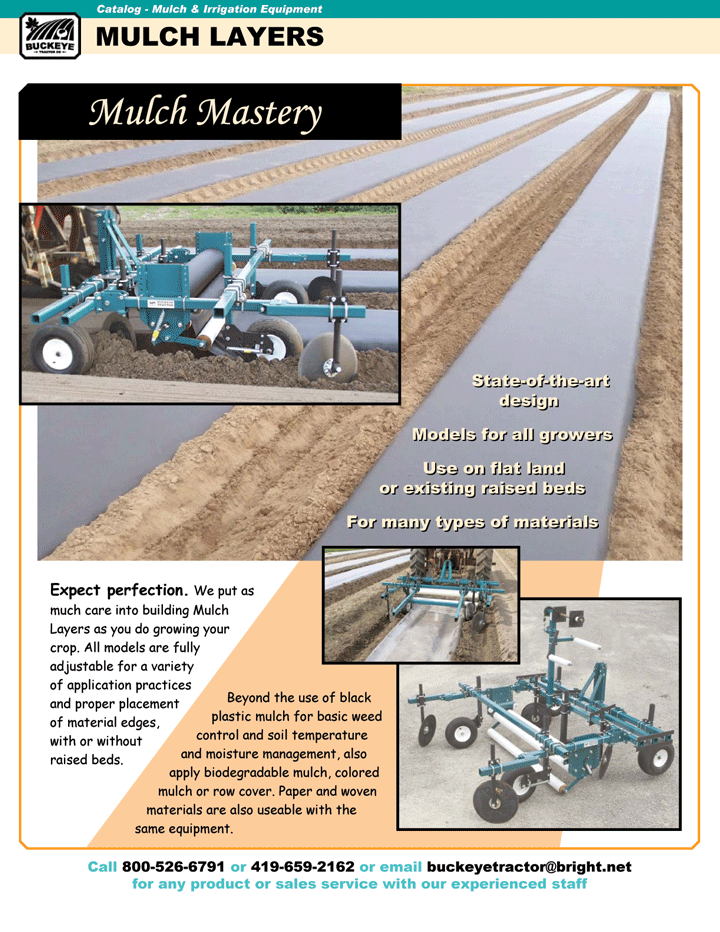Chris Kott wrote:I believe some people use chisel plows to keyline plow their land. I have always thought that this is a good idea, where appropriate, and that if there were a hopper right behind the knives, directing wood chips or other organic matter down to the bottom of the cut, that would basically serve some of the same functions as any buried wood application.
I don't like plastic mulch. I understand why some people think it's necessary, but I don't like it. I think if it is required, there is something wrong with the system. I wouldn't bother with it.
Two ideas I like much better are dedicated pathway areas, spaced exactly so as to accomodate the wheel ruts of the equipment you're using, all planted with soil-building plants that hold onto soil structure really well. I haven't nailed down the species yet, but I think that non-seeding, non-spreading comfrey people like to use for edging on their naturally bordered beds would do really well, along with green manure crops selected for long period of growth, such that you roll them down or mow them before they go to seed.
You could alternately have alternating strips of raised beds and fallow green manure and soil-building mix. You could rest the fallow strips a whole season, and if done on-contour, they would hold onto a massive amount of the topsoil regular working would otherwise rob from you.
If you are looking to build soil at an increased rate, as suggested by the amendments you want to till in, I can understand you not leaving permanent fallow strips, as you'd want, at some point, to put biochar and stuff there, too, if you want to work faster than the worms. But that is also an option, working only the beds, amending them to the hilt, and boosting soil life, specifically worms and appropriate fungi, and relying on that boosted soil biology to move everything to the undisturbed strips between. This would offer the advantage of holding the structure of the land better, and would better enable soil life to recolonise the worked strips or raised beds after tillage.
The equipment you're using looks interesting. Honestly, there are areas that exist on earth where just running that blue thing on-contour would result in enough texturing of the land to cause re-greening of whatever type is natural. I think that the microclimates it offers you aren't to be overlooked, especially if you read your land right as it pertains to the sheltering effects of that texture.
Please keep us posted, and good luck.
-CK
Wow, so much alike in thinking and some great tips.
First about the keyline plowing, my land has a slight slope and the way I am chisel plowing now is also keylineing. For those who don't know, keyline plowing is chisel (or other types of deep plowing and basicly making small trenches that instead of going up n down the slope are instead going sideways on the slope). This then stops the water from draining down hill and instead allows the water to drain into the ditch. Theoretically letting the water soak better into the soil instead of just draining on the top, eroding topsoil. Sometimes it helps sometimes not (as with much things with soil, your soil texture, depth of tillage, crop on top and many other factors can effect how well this does or doesn't do). And I luv the idea Chris about putting wood in these slices in the soil, I'm just not sure how I could add sawdust (preferably inoculated w/ mushrooms) into a 1/2" wide by 12-18 inch deep hole. Any pipe trying to deposit this would probably clog up and because of my sized tractor I couldn't go wider (say 1" wide x 18" depth) as this would need a huge tractor (over 75 HP) and I would need way more land to justify owning such huge equipment. Besides I like my ole' gal. She's a 70 year old tractor (1950 Farmall Super A).
Second, the mulch, I would be using a woven type that would be reusable. This would help reduce (though not eliminate) me adding to landfills. Also the woven type allows water to soak into the ground, it does though kill weeds which may not be an issue because of my intensive farming planting. With this type of planting you instead of planting 1 row every 3 feet between rows and then spacing plants (depending on plant) 2-18" apart as in normal row cropping. Instead you plant them in rows the same distance between rows in the bed as you plant them spaced "IN ROW". Example okra is planted normally in rows spaced 3 ft apart and spaced every 10-12 inches in the row. In intensive farming I'll be planting them on a 48" wide bed and have each row AND spaced between plants in the row every 12 inches. I only need to cultivate 1-2 times when the okra seeds first pop up and possibly the second time when the plants get to about 12" tall. After that the okra themselves shade between the plants keeping weeds down. Also me possibly adding sawdust mushroom mulch (I really like this idea and will look farther into this) and also adding a side dressing of vermicucompost as a mulch will also help keep weeds down. So I may NEVER need plastic mulch, but most larger scale farming says thats what you need if your not growing GMO's and using roundup (things I would NEVER DO!!!). So I hopefully wouldn't ever use plastic, BUT I am keeping an open mind to do whatever I would need to do to maximize production but still remain as organic as possible.
Third, I like the alternating row idea but I would instead do every 3rd row as right now I am instead rotating between 3-one acre plots and 1 of the 3 is in legumes all year, though part of that year the legumes are also a cash crop (planted in beans, such as red beans, black eyed peas, pink-eyed purple hull, and/or crowder peas. The only issue would be it may be harder to keep up the rotation of crops and this would also mean that the insects that ate one type of plant is now only 3-8 feet from them the next year when I rotate the rows. Versus hundreds of feet if I planted my crop from last year into a different acre of land. This may not help much for flying insects, But I'm at least thinking the farther they have to go to find the specific type of plants these insects want to eat the harder it is they may find them, or they may even find something in my neighbors yard more attractive to their liking than trying to find what I moved over hundreds of feet. (OH look the neighbors planted a garden too, lets fly that way) LOL (I know, I'm bad neighbor hunh LOL) but that'll teach em to let their yard grow bindweed, thistles, broom-sage and the dreaded coffee bean weed and Solidago canadensis (aka goldenrod)... Got a funny story about something like this (one of my neighbors has 60-70 bee hives on his land. my other neighbor decided to build a pool in their back yard. This June, July and Aug I see them jumping into the pool but then running for their lives as in the hottest part of the summer these bees while flying to my house to pollinate my flowers/veggies, decide to stop off and get a drink LOL well you can guess the rest... They now have a kiddie pool without chlorine in it, and their dogs and the bee's both prefer it to the larger pool...)
Fourth, you mentioned the walkways (aka where my tractor tires ride between the beds) I like the idea of non-spreading comfrey. I'm not sure if it could handle heavy traffic such as me walking on em harvesting, watering, adding side dressings etc along with my tractor driving over them. I will look into it though. But one thing I have seen that is great for a cover crop that is low growing, can handle heavy traffic and is a legume too boot is white perennial clover such as Dutch clover or Ladino Clover. These are in many pastures here and do fine even where cattle and/or equipment/trucks etc are driven daily. I would just have to stay off it when getting it established but after it gets over 2" tall it wouldn't harm it walking on em and by 3" tall even the heaviest tractors can't kill the stuff...

 2
2




 1
1

















 1
1




 1
1



































 2
2






















 1
1




 1
1








 1
1










